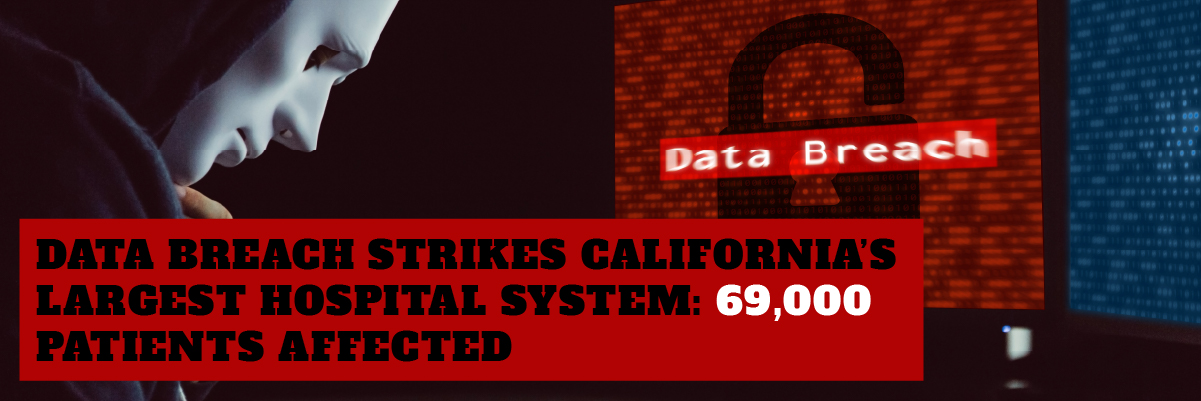Hackers gained access to the test results of tens of thousands of patients at California’s leading hospital system.
What Happened
Kaiser Permanente, the nation’s largest nonprofit health plan provider, has announced a data breach that exposed almost 70,000 individuals’ sensitive health information.
According to TechCrunch, the breach of Kaiser Permanente’s systems was first disclosed to patients in a June 3 letter. According to the letter, the breach was first discovered on April 5, when officials learned that an “unauthorized entity” had accessed a Kaiser employee’s emails. The emails contained “protected health information” about tens of thousands of Kaiser customers. According to a second filing with the Department of Health and Human Services, the total number of people affected by the breach is 69,589.
The exposed data includes first and last names, medical record numbers, dates of service, and laboratory test result information according to the disclosure letter. Still, no social security or credit card details were involved.
According to Kaiser’s email to customers, which was published, “we terminated the unauthorized access within hours of it occurring and promptly initiated an investigation to identify the magnitude of the event.” “We found that the emails contained protected health information, and while we have no evidence that an unauthorized party accessed the material, we cannot rule out the possibility.”
Though the HHS document classifies the incident as a “Hacking/IT Incident,” it’s unclear how the “unauthorized person” got access to the emails.
 What It Means
What It Means
Over the last few years, the healthcare business has seen an influx of unwanted attention from cybercriminals. A data breach at a Massachusetts healthcare company exposed information on the treatments that up to two million people had received, as well as their names, birthdays, and Social Security numbers, only last week. We recently saw a data breach at Eye Care Leaders, so it’s becoming common for healthcare organizations every day. During the pandemic, hospitals and healthcare providers were popular targets, and it’s easy to see why. Medical facilities are attractive targets for cybercriminals because they store massive databases of personal information that can be ransomed, stolen, or sold on the dark web. The cybersecurity defenses provided by hospitals’ antiquated digital infrastructure aren’t the finest in the world.
Human Error is Still a Threat to Security
The event also highlights what has always been and continues to be the most significant security risk businesses face in human error.
According to Verizon’s 2022 Data Breach Investigations Report (DBIR), which takes a complete look at data breaches from the previous year, 82 percent of the intrusions studied last year featured “the human element,” which can mean a variety of things.
“Whether it’s the use of stolen credentials, phishing, misuse, or simply an error,” researchers wrote in the report, “humans continue to play an eminent part in incidents and breaches alike.”
Protected Harbor’s Take on The Matter
“The threat of Business Email Compromise (BEC), which appears to have occurred in the Kaiser incident, is particularly serious.”- said Richard Luna, CEO of Protected Harbor. Socially designed phishing and other malicious email campaigns trick unwary employees into giving up credentials to their business email accounts have become increasingly sophisticated.
Once a threat actor has secured early access to a firm network, this might lead to more malicious operations, such as ransomware or other financially driven cybercrimes.
In fact, BEC has become a big financial drain for businesses, with the FBI recently reporting that companies spent $43 billion on this type of attack between June 2016 and December 2021. In fact, there was a 65 percent increase in BEC schemes between July 2019 and December 2021, which the FBI ascribed to the epidemic forcing most business activity to take place online.
Tips to stop BEC & Common Attacks
Upstream Spam Filter- Spam filters detect unsolicited, unwanted, and virus-infested emails (also known as spam) and prevent them from reaching inboxes. Spam filters are used by Internet Service Providers (ISPs) to ensure that they are not transmitting spam. Spam filters are also used by small and medium-sized organizations (SMBs) to protect their employees and networks.
Inbound email (email that enters the network) and outbound email (email that leaves the network) are both subject to spam filtering (email leaving the network). ISPs use both strategies to protect their clients. Inbound filters are usually the focus of SMBs.
2FA– 2FA is an additional layer of protection that verifies that anyone is attempting to access an online account are who they claim to be. The user must first provide their username and password. They will then be requested to submit another piece of information before they can receive access. This provides an additional layer of security to the process of gaining access.
Applying Recent Security Updates– Updating your software is very important, and it’s something that you should never overlook. Frequently updating your devices and installing the latest security updates can help to protect you from cyber threats and keep your devices secure.
Restricting User Access to Core Files (Access Control)– Access control is a security approach regulating who or what can view or utilize resources in a computing environment. It is an essential security concept that reduces the risk to the company or organization. Access control is a critical component of security compliance programs because it guarantees that security technology and access control policies are in place to secure sensitive data, such as customer information.
Network Monitoring for Malicious Activity– Network security monitoring is an automated procedure that looks for security flaws, threats, and suspicious activity in network devices and traffic. It can be used by businesses to detect and respond to cybersecurity breaches quickly. Network monitoring identifies and analyzes weaknesses, notifying you of potential security threats. Cybersecurity alerts enable you to swiftly safeguard your company from network attacks and the resulting calamities.
User Activity Monitoring- User activity monitoring (UAM) solutions are software tools that track and monitor end-user behavior on company-owned IT resources such as devices, networks, and other IT resources. Enterprises can more easily spot suspicious behavior and manage risks before they occur in data breaches, or at least in time to minimize damages, by deploying user activity monitoring.
Final Thoughts
In a world where cyber-attacks are common and more sophisticated than ever before, businesses must take steps to protect themselves and their customers from data breaches and other cyber threats. One way to do this is by partnering with a trusted company that offers unparalleled cybersecurity solutions.
Thanks to our innovative cloud-based approach to security, you can be sure that your company will be well protected against the ever-evolving threats to data security. By thoroughly examining your company’s network security and other aspects of its IT infrastructure, we can identify areas of weakness and suggest ways to correct them.
Visit Protectedharbor.com today to get a risk-free review of your current IT security solution. You’ll receive a detailed assessment of your current security setup and recommendations for improving your security posture.[/vc_column_text][/vc_column][/vc_row]







